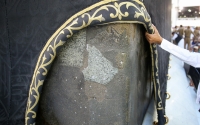
Rukn al-Yamani or Yamani Corner is one of al-Kaaba al-Musharrafa's four pillars and one of two pillars from which the kiswa risesin two parts, as pilgrims tend to kiss and touch them seeking reward. It is located in al-Kaaba's southwest corner, and is flanked on the southeast side by the Black Stone. It is surrounded by a handmade ornament that is embroidered with gold-plated silver wire, adding elegance and glamour to distinguish it from the other corners. The dimensions of the embro...

The General Presidency for the Affairs of the Grand Mosque and the Prophet's Mosque works on electronically coding the locations of the Holy Mosque for several key objectives, including: Dividing the Grand Mosque and its surrounding courtyards. Adding codes to the pillars of the mosque for easy for reference. Placing QR codes on each pillar to provide information about locations and directions. ...
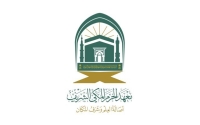
The Holy Mosque Institute is a specialized scientific institution focused on Islamic jurisprudence, based in the Grand Mosque in Makkah al-Mukarramah, Kingdom of Saudi Arabia. The idea of establishing the institute was proposed in 1965 by Sheikh Abdullah Bin Humaid, the head of religious affairs of the Grand Mosque. He suggested to King Faisal Bin Abdulaziz Al Saud the creation of a religious institute within the precincts of the Grand Mosque. The purpose was to create a center for education, g...
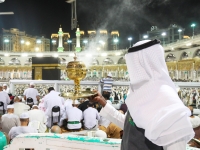
Perfuming and Fumigating the Grand Mosque is the process of spreading incense in the prayer areas of the Grand Mosque, and daily anointing the walls of the Kaaba, its covering, the Yamani Corner, and the Black Stone with various types of luxurious perfume. This practice is a manifestation of the reverence for the House of Allah and the Holy Kaaba. Method of Perfuming and Fumigating the Grand Mosque The process of perfuming the Black Stone and the Multazam with premium oud oil is repeated five t...
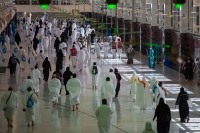
Al-Mas'a is the place where Hajj pilgrims and Umrah performers perform the ritual of Sa'i between the hills of Safa and Marwa. It is located to the east of the Grand Mosque in Makkah al-Mukarramah, the Kingdom of Saudi Arabia. The Sa'i is performed in laps different from those of the Tawaf around al-Kaaba al-Musharrafa. Walking from Safa to Marwa is counted as one lap, and walking back from Marwa to Safa is counted as another lap, continuing in this manner until completing seven ...
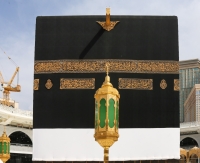
The comprehensive restoration works of al-Kaaba al-Musharrafa during the reign of King Fahd Bin Abdulaziz Al Saud in 1996 were preceded by several procedures that served as preliminary steps for starting the reconstruction of al-Kaaba in the largest restoration operation during the Saudi era. These procedures included: 1. Removing the tiles from the walls of al-Kaaba. 2. Inspecting the exterior wall of al-Kaaba. 3. Numbering the interior stones of al-Kaaba to return them to their original place...

The Department of Languages and Translation at the Grand Mosque in Makkah al-Mukarramah is responsible for several specific mandates to facilitate the service of pilgrims, visitors, and Umrah performers. These mandates include: Responding to inquiries. Direction and guidance. Direct translation of sessions and lessons. Deploying translators throughout the Grand Mosque who speak twenty-one languages. Providing sign language interpreters for people with disabilities. Translating sermons and lesso...
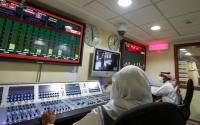
The sound systems in the Grand Mosque in Makkah al-Mukarramah are distinguished by several features that set them apart from most other systems. These features include: Connection to over seven thousand speakers. An error rate not exceeding 0 percent. Use of highly sensitive microphones. Daily sound balance adjustments. Connection to two control rooms for managing the sound systems and their components. Being considered among the largest and most advanced sound systems in the world. ...

Hijr Ismail is a crescent-shaped wall adjacent to al-Kaaba al-Musharrafa from its northern side. It has short wooden doors on both the eastern and western sides that connect it to al-Kaaba when closed. In its center, the rains pour into the Kaaba's rainwater drainage system (Meezab-e-Rahmat), and it is the only side of al-Kaaba where the Shadherwaan is at a lower level. Hijr Ismail's association with al-Kaaba al-Musharrafa Hijr Ismail is closely associated with al-Kaaba al-Musharrafa,...
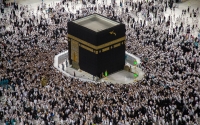
Washing al-Kaaba al-Musharrafa is done to purify it from any blemishes and impurities that may be attached to it. This involves washing and wiping its walls with a special mixture, following the Sunnah of the Messenger of Allah, peace be upon him (PBUH), upon the conquest of Makkah in 630. Al-Kaaba is washed in the month of Muharram every year, and the washing ceremony is presided over by the Custodian of the Two Holy Mosques or his representative, with the attendance of several senior official...
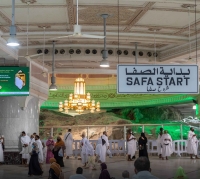
The General Presidency for the Affairs of the Grand Mosque and the Prophet's Mosque works on implementing the procedures approved by the Saudi Energy Efficiency Center to enhance energy efficiency and conserve energy consumption in the Grand Mosque through several measures, including: Converting all lighting units installed throughout the Grand Mosque to LED type. Providing sensors and detectors to turn off lights in facilities devoid of employees. Working towards achieving the highest lev...

Al-Kaaba's Kiswa is the piece of cloth that covers al-Kaaba al-Musharrafah. It is woven with silk, gold, and silver threads on an annual basis. This tradition dates back to the construction of al-Kaaba until the era of the Founder of the Kingdom of Saudi Arabia, King Abdulaziz Bin Abdulrahman Al Saud, who regulated the affairs of the Kiswa and ordered the establishment of a factory for manufacturing al-Kaaba al-Musharrafah's Kiswa in Makkah al-Mukarramah. In 1927, the factory was e...